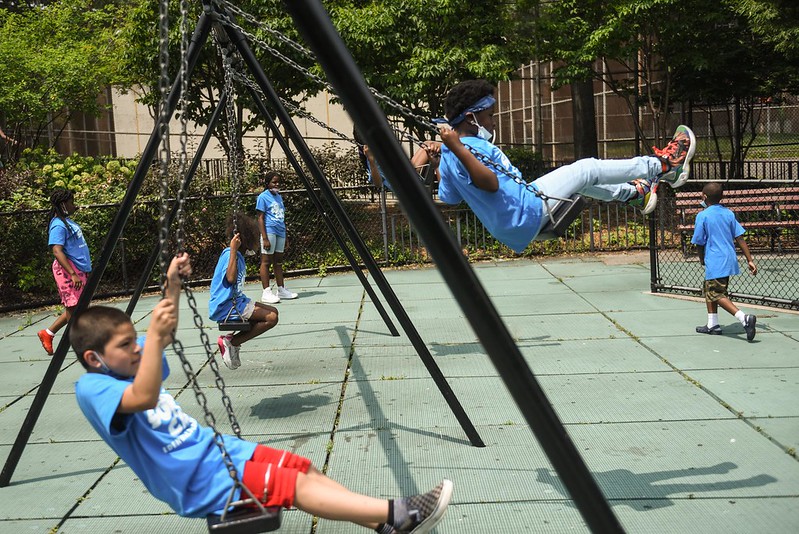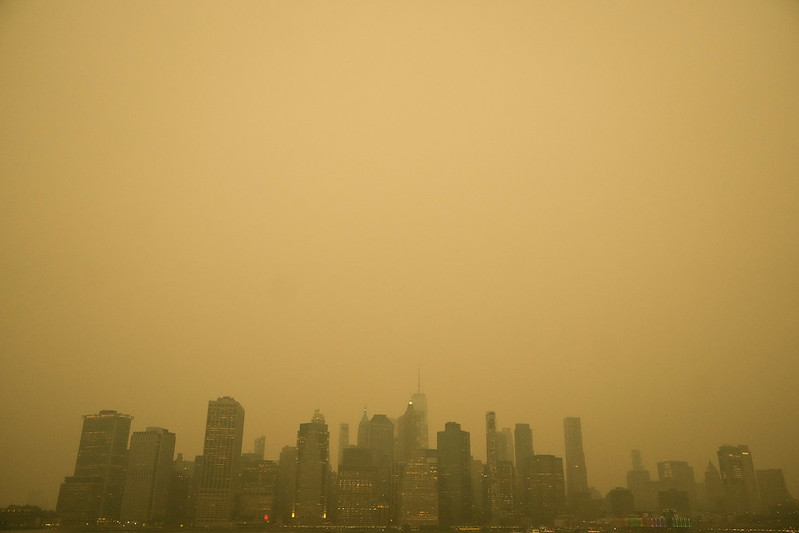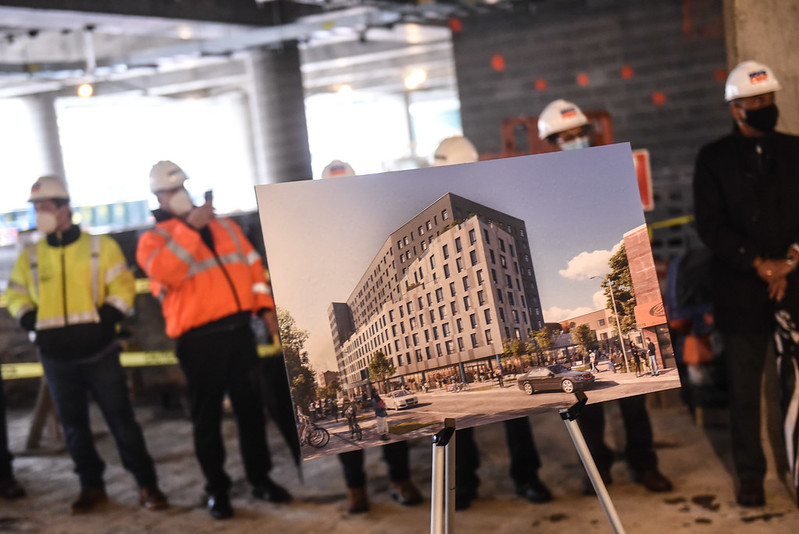Building Healthy Minds, One Sport at a Time

Kids at play (photo: Michael Appleton/Mayor's Office)
If we want to give New York City kids the building blocks to excel academically, we have to invest in physical education — and that means recommitting to the groundbreaking, but now defunct, PE Works program.
In 2015 then-Comptroller Scott Stringer issued “Dropping the Ball,” a report detailing the many failures of the City’s ability to engage students in physical activity. The report echoed many of the tenets of Michelle Obama’s “Let’s Move” campaign to combat childhood obesity, and pointed out that “active students are better able to engage in the classroom and excel academically.”
Around the same time, the City established the PE Works programs, which had tremendous results. In its initial pilot phase in the 2015-16 school year, it found that “almost all (96 percent) of elementary schools failed to provide the required time and frequency of PE instruction that is necessary for young students to master PE skills according to State standards.”
The program, which rapidly expanded citywide, sought to overcome “historical barriers to physical education by first giving principals the funds and hiring support to re-prioritize PE.” By the time funding ran out after the 2018-19 school year, 78.9 percent of elementary students were meeting PE time requirements and nearly every elementary school had a PE teacher.
In the four years since, we have not made any further progress.
In the most recent report for the 2021-22 school year, 77.1 percent students are meeting required PE time, a number that drops to 64 percent for K-5 students. That dropoff is concerning given that preliminary evaluations of the PE Works programs found grade 4 and 5 students in particular showed “larger and steadier” yearly improvements in aerobic capacity compared to students not in the program.
Shortfalls in activity have significant consequences for our youth, and we know that when physical education is not addressed in schools the physical activity gap starts to look a lot like the income gap. Poorer students cannot afford club sports, which have grown increasingly expensive and elite, and parents often do not have the time or ability to drive them to practices and out-of-town games. As a result, poor children become less physically active, less healthy, and less academically engaged than their peers.
According to The New York Times, the CDC recently found just 31 percent of kids from families at or below the poverty line were participating in sports, compared to 70 percent of kids from families making at least $105,000 a year, and 51 percent for families in the middle income ranges. Gaps in physical education, like gaps in reading, writing, and math, should not become an accepted outcome of disparities.
In 2020, faced with the problem of keeping kids active, we launched a platform, Hiveclass, which makes physical education and youth sports training available through remote learning. We started this company and created a standards-based physical education curriculum, based on our own personal experiences and frustrations during the pandemic — but for many kids, COVID-19 was only one barrier to physical activity.
As we’ve grown, so have our goals. Today we are committed to making quality instruction in physical education accessible, supporting good mental health and providing the building blocks for advanced skills to kids everywhere.
In New York City, this remains a persistent challenge.
According to the Physical Activity Alliance, National Report Card, New York ranks 40th out of all states and the District of Columbia when it comes to the percentage of young people active seven days a week, with fewer than 20 percent saying they are active every day. The same report also ranked New York 30th when it comes to obesity rates, with more than 30 percent of students overweight or obese.
Our company is committed to closing these gaps. We offer high-quality sports and physical education instruction, primarily by partnering with school and library systems, to children from all income levels. Our goal is to provide the discovery, joy, curiosity, and freedom to try new things to all students. By combining technology, entertainment, and education we hope to inspire kids to partake in different sports and activities with their peers.
Though our digital platform is designed as a vital resource to deliver standards-based physical wellness education, teachers can use the platform during in-class instruction as well as for less traditional remote learning. Meanwhile, libraries encourage physical activity at home or at the park where access to organized team sports may be limited.
We need the City to do its part and fund our schools so that all of New York public school students, especially our most vulnerable, get the tools they need for a healthy, active, and academically-fulfilling life.
***
Joe Titus is the Co-Founder and CEO of Hiveclass, an online sports and fitness training platform with a goal to make quality instruction in physical education accessible to kids everywhere. On Twitter @hiveclass.
***
Have an op-ed idea or submission for Gotham Gazette? Email This email address is being protected from spambots. You need JavaScript enabled to view it.
Wildfire Smoke Should Help All New Yorkers Understand the Need for Clean Air Solutions Like This One

Wildfire smoke upon New York City (photo: Michael Appleton/Mayor's Office)
There is an old expression: “Opportunities are like sunrises. If you wait too long, you miss them.” As someone who has lived in and around public housing in Western Queens for more than 40 years and has dedicated my life’s work to this special community, we have lived through a very long night, but now we can sense the sunrise, and we are determined not to miss it.
The recent unhealthy air from the smoke of Canadian wildfires have given all New Yorkers a taste of what Western Queens residents have long experienced.
For decades, our communities have lived in the shadows of fossil fuel power plants. These plants, along with other nearby industrial activity, have darkened our skies and poisoned the lungs of thousands of residents who live in public housing developments disproportionately clustered around these noxious polluting facilities.
In the ongoing battle against climate change, the dangerous combination of fossil fuel emissions and wildfires that we have just witnessed has emerged as a formidable threat to public health, particularly in marginalized communities.
I co-founded Urban Upbound with the mission to break cycles of poverty in public housing communities by bringing people together to solve multi-faceted problems ranging from community health to jobs to revitalizations. I know better than most how rare it is to build an alliance that spans community leaders to labor to business, all together behind a comprehensive solution.
The time for urgent action, equity, and environmental justice has never been more pressing — that is why the Renewable Ravenswood and the Attentive Energy One offshore wind projects are critical measures, and state leaders must make sure we don’t miss this opportunity.
Renewable Ravenswood will be the largest environmental justice project in our state’s history. It charts a path to transform Ravenswood Generating Station — New York City’s largest fossil fuel power plant — to a state-of-the-art clean energy hub, even resulting in the ultimate shutdown of “Big Allis,” once the largest generator in the world. If you’ve ever spotted the massive smokestacks towering over the neighborhood from the Queensboro Bridge or the N Train, you’ll understand how big of a deal this would be.
The first step in this transformative vision is the proposed Attentive Energy One offshore wind project. By connecting an offshore wind farm to Ravenswood, we will see the retirement of one of Ravenswood’s 1960s-era fossil fuel generators – not just in our lifetime, but in the next decade.
This project would make massive investments in our community, creating good-paying jobs while reducing carbon dioxide emissions equivalent to removing 13% of cars off New York City streets. The project would stabilize energy costs at a time when high electricity bills continue to impact working families and would leverage Ravenswood’s existing energy infrastructure and workforce to reduce construction costs while preserving good-paying union jobs.
The retirement of local fossil fuel infrastructure powered by clean energy is important enough that President Joe Biden’s Secretary of Energy, Jennifer Granholm, visited Ravenswood this Spring saying this project is “a fantastic story of transformation” and “an example of what could happen all across the nation.” Importantly, this plan is the product of bottom-up conversations with the community on solutions to uplift us. Between years of transparent engagement by Rise Light & Power, NYCHA residents’ inclusion in Secretary Granholm’s visit, and upcoming community forums, this project has the full backing of the community and we are ready to see it happen.
This is the moment where all New Yorkers can understand the importance of breathing clean air and seeing a bright sunrise.
There is little New Yorkers can do to stop raging wildfires, but our leaders can take immediate action now to help Western Queens and New York City breathe easier by supporting Attentive Energy One -- the clear gateway to clean air for Western Queens and better opportunities for everyone in our community who has lived in the shadow of neglect for far too long.
***
Bishop Mitchell G. Taylor is the CEO and co-founder of Urban Upbound.
***
Have an op-ed idea or submission for Gotham Gazette? Email This email address is being protected from spambots. You need JavaScript enabled to view it.
Don’t Be Fooled by New York’s Illusionary Zoning

Zoning and housing in focus (photo: Michael Appleton/Mayor's Office)
Zoning is often discussed like it’s an occult force with mystical powers. I’ve spent decades overseeing New York City’s zoning, and I promise, it’s not magic. It’s an important planning tool to direct where the housing, jobs, and other facilities the city needs can be added, but its mystique can obscure important realities.
The misuse of zoning, often driven by good intentions, is a major cause of the structural housing shortage that drives up housing prices for everyone, fuels gentrification pressure, drives some New Yorkers to leave the city, and leaves others inadequately housed or homeless. Decisions that look like they should move us forward push us backward. I call this phenomenon Illusionary Zoning.
Here is a field guide to common species of Illusionary Zoning, and how government decision-makers can better use zoning with other tools to alleviate our housing crisis.
Exclusionary Zoning in Disguise
It’s easy to blame the suburbs for anemic housing production. We’re all familiar with exclusionary zoning that allows only large, single-family homes – banning lower-cost housing and walling out newcomers, the working class, and people of color.
New York City is more dense and diverse, but often has zoning that makes it look like new housing can be built, when in fact it can’t.
Less than one-sixth of New York City’s land is zoned explicitly for single-family homes only – less than most other cities, and certainly less than the suburbs. But over half the city lies within lower-density residential districts, many of which subtly prohibit multi-unit buildings through requirements for parking or yards or other controls.
Other neighborhoods have “shrink-wrapped” existing buildings with highly restrictive rules created over the years to prevent changes that would be “out of character.”
Both approaches effectively freeze current conditions in place, allowing new housing only as a costly minor exception.
Because of these rules, it’s impossible to replicate the existing two-family homes or garden apartments found in low-density neighborhoods like Riverdale or Bayside, and there are portions of the Upper East and Upper West Sides and Greenwich Village where the number of homes is actually declining.
It’s not that people don’t want to build housing; it’s that they’re not allowed to.
Many people who want to live in these neighborhoods find they can’t, so they look to the next neighborhood, where prices are somewhat lower – a recipe for gentrification. But for all the attention to battling the problems created by gentrification, somehow the well-heeled neighborhood nearby that has quietly prevented new housing escapes scrutiny for its role in this process.
Do you remember how decades ago, as artists, students, and professionals moved to Williamsburg and housing prices rose dramatically, there was a popular outcry about the need to build more housing in Greenwich Village? Neither do I.
It’s a feat worthy of an illusionist.
Transactional Zoning
The process of changing zoning for a site can take years and add $50,000 or more to the price of an apartment. If all new housing – even just the insufficient amount built today – required a rezoning, it would require 10 times the city agency staff, Community Board meetings, and thick environmental review documents. There’s simply no way to produce enough housing with a process this burdensome.
Nonetheless, in the common practice of Transactional Zoning, only land controlled by the owner who is applying gets rezoned. Neighboring sites are left to each pursue their own approvals, even if grouping them would be beneficial and more efficient. This gives local officials an opportunity to pressure each developer to address community priorities. But shaping one development comes at the cost of making building more costly on every other site. This is a pyrrhic victory that compounds the shortage of housing.
Strings-Attached Zoning
New York City has long been a leader in the creative use of zoning to advance other public goals such as affordability and open space. But when zoning focuses too much on other objectives, it can boomerang and undermine its core purpose.
Recent research from Seattle illustrates how a “strings attached” approach can backfire. Housing density was increased in several areas while adding a requirement for affordable housing, but without properly assessing the feasibility of building under these rules. As a result, the result was the opposite of what was intended: not only was the desired affordable housing not built, but housing production dipped in intended growth areas, and was pushed to surrounding areas.
Ignoring feasibility can produce the same effect as traditional exclusionary zoning. For instance, high parking requirements for new housing don’t produce lots of housing with large parking lots; they mostly stop housing from being built, because providing all that parking is too costly or physically impossible.
Wishful Zoning
Sometimes we know enough to avoid Strings-Attached Zoning but do it anyway, because it sounds like such a good idea.
New York City’s Mandatory Inclusionary Housing program requires 20 to 30 percent of units to be affordable when land is upzoned. This is often less affordable housing than neighborhoods desire. But the 2015 financial feasibility assessment for MIH found that even these levels of affordability relied on the availability of a tax incentive like the recently-expired 421-a program.
Many of the same people who want to increase affordability in rezonings are hostile to replacing the expired 421-a program. But mapping MIH without a 421-a replacement is Wishful Zoning – on paper, it sounds like more housing and more affordability, but in practice we’ll get neither. Achieving better housing outcomes requires more than wishful thinking.
Hungry Hungry Hippos Zoning
Sometimes a rezoning proposed for a privately-financed new building, which would require no direct public subsidy, faces rejection unless more units are made affordable. This can be accomplished by publicly-subsidizing additional affordable units.
Problem solved? Well, it’s really more sleight of hand.
Housing subsidies are available in fixed annual amounts set by legislatures in budgets. In a typical year in New York, all these dollars are committed to projects. So giving more funding to one project means less is available for another.
When a privately-financed development in Manhattan or western Queens is compelled to use public funding, it may look like a decision-maker has created more affordability. But they’ve really taken it away from some unspecified building in, say, the South Bronx or Central Brooklyn.
And because zoning proposals are typically seen as local matters, no one speaks up for the other neighborhoods that would quietly lose affordability.
Shattering the Illusions
So what can we do with zoning to help deliver the housing we need?
We can ease restrictive zoning and other regulations where people want to live – not just neighborhood by neighborhood, but across the board. This means allowing not just somewhat larger mixed-income buildings near transit, but also accessory dwelling units and other forms of “gentle density” in lower-density areas. Enabling a bit more housing everywhere counteracts the concentration of market pressure that we see in the vicious cycle of exclusion and gentrification.
We need to reduce the procedural and administrative burdens we place on new housing. This doesn’t mean there should be carte blanche for any building anywhere. But every home we force through a yearslong process takes us a step further from meeting our urgent housing needs.
Finally, when reviewing rezoning proposals and ideas to improve them, we need the City Planning Commission, City Council, and others to leaven local considerations with questions about the broader implications of decisions: Will this help create more housing overall? Will this increase the amount of affordable housing built in the city, or just shift resources from one community to another?
Until we do these things, we should harbor no illusions that we’re fixing our housing crisis.
***
Howard Slatkin is Executive Director of Citizens Housing & Planning Council and formerly Deputy Executive Director of Strategic Planning for the NYC Department of City Planning. On Twitter @hslatkin & @chpcny.
***
Have an op-ed idea or submission for Gotham Gazette? Email This email address is being protected from spambots. You need JavaScript enabled to view it.




